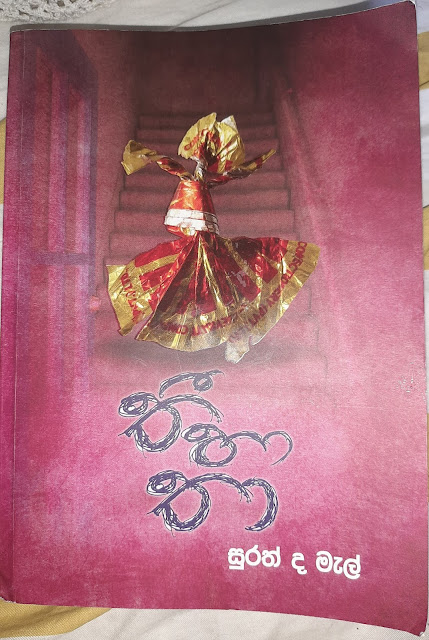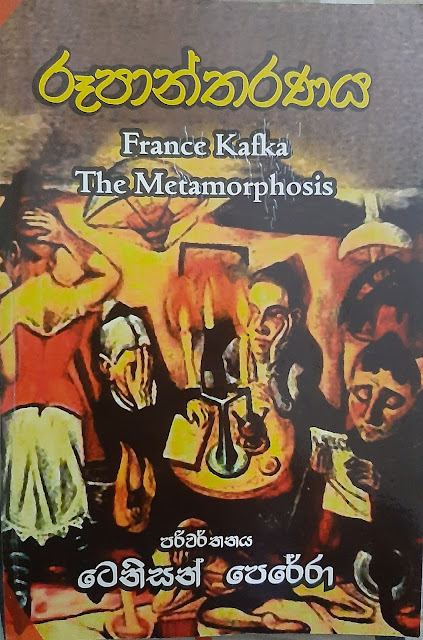I, a failure in tertiary education and as a professional, can find solace and motivation in reading success stories. I was in the field of financial statement auditing and now currently working in a Sri Lankan private sector Licensed Commercial Bank (LCB) can learn a lot from such stories.
Being a banker in training in the present gives me the opportunity to learn a lot of life lessons from a biography of a previous legendary banker.
Mrs. Rohini Nanayakkara (RN) is two generations apart from mine. She had her primary education during the colonial era before independence. She was from a good family background according to her memoir. One of her uncles was the well-renowned politician and lawyer Dr. Colvin R. De Silva.
In the "Prologue" of the book the author, Michelle Gunawardana explains the character of RN, she observed during her process of completing the book which is very inspiring. According to the author, her greatest achievement is becoming the Chief Executive Officer (CEO) or the head of Bank of Ceylon. (BOC) And also the writer explains that in her seventies she is still very energetic and forceful in her personal and professional life.
In the chapter "Early days" the readers are exposed to her family, her schooling at Methodist College, her selection and tertiary education at Peradeniya University, and her memories at home for one year after graduation.
The book and the story are valuable because of what it represents. It represents a woman breaking all the barriers in her career and achieving her full potential.
In the book, there are chapters that include different perspectives of different people who knew Mrs. Rohini Nanayakkara (RN). These chapters are titled "Impressions".
Mrs. RN applied to an advert in a newspaper allowing her and another lady (Mrs. Nalini De Silva) to be the first female bankers in Sri Lanka.
On April 01st, 1959 she was starting her career as a banking assistant.
As per the guidelines of the management considering her safety she was first assigned to the "personnel department".
After two years she requested a transfer to real bank operations.
In 1961 Bank of Ceylon was nationalized supporting the political policy of the government of that period.
Mrs. Rohini Nanayakkara was assigned to the current accounts department as per her request. This was the unit where basic banking functions of commercial banking, accepting deposits, and issuing cheques took place.
Quoting the book what her main role at the current accounts department was,
"My task, as a ledger officer was to supervise and check the clerical records of each and every transaction of the customer accounts allotted to me. In practice, it meant 'canceling' (initialing) hundreds of credit and debit entries on the customer ledgers - large, thick sheets of paper, one for each customer, arranged in alphabetical order - after checking the entries against piles of cheques and transaction slips that arrived on my desk each day. The entries were posted to the ledgers by the ledger clerks or machine operators as they were known because the process involved a kind of mechanical swiping operation, a little like the manual credit card swipe machines of today."
(Pg. 35-36)
Her gender garnered her respect in the department she worked with supportive peers and subordinates.
Mrs. Rohini was then transferred to the clearing department and then-current accounts which lead to a tiresome experience for her. During this period there was a major strike called by the powerful Ceylon Bank Employees Union and all the clerical staff joined the strike. It was challenging to do clerical work but for three months they (the bankers) managed to work it out.
And again she was moved to the loans department where she actually felt that she was involved in banking operations. And also it allowed her to meet many leading businessmen like Mr. Hinniappuhami (Founder of Maliban group) and Mr. A. Y. S. Gnanam (Founder of St. Anthony's Industries Group) And also being in the loans department allowed her to work with senior officers of the bank allowing her to grow her professional life skills as well as exposure in bank operations. In 1968 she was elected for president of the staff officers' association which allowed her to gain experience in organizing events in the bank and also to manage welfare matters of the staff.
In the chapter "Unexpected events" Mrs. Rohini Nanayakkara explains that,
"after the JVP insurrection the unions became very aggressive, the repercussions of the 'Sinhala only' policy were being felt, and the rather genteel culture that had prevailed at the bank gradually eroded. The board was politically appointed, and standards dropped noticeably."
(Pg. 40)
With the approval of the bank, she worked in the Ministry of Plantation Industries with the offer of Dr. Colvin R. De Silva in 1971. In 1972 she was given the opportunity to work in London, the United Kingdom for Tea related research where she meets her future husband, Mr. Cyril Nanayakkara. In 1972 she gets married.
She spent her honeymoon traveling all around Europe. After that, they moved into Mr. Cyril's one-bedroomed apartment in London. A few months later she was expecting her first child and then she started feeling homesick which was later changed by finding a trainee position in Midlands Bank in London, for a six-month period in the bank's overseas division.
On 09th August 1973, her first child Mr. Ruwan Nanayakkara was born.
After her training and her time in London, UK she leaves for Sri Lanka with her child and her role was to be the branch manager of Bank of Ceylon's new Wellawatte branch.
After some time in Wellawatte, she moved to Belgium with her husband in 1976. Mrs. Rohini was able to gain another training in the international banking department of the Bank Brusselles Lambert.
It is evident that her luck has always been with her during her career and her personal life. She was able to enjoy many of the things that few privileged people in Sri Lanka had. She also was well organized and balanced giving her the opportunity to utilize her luck to achieve her full potential.
The benefit to the reader of this memoir is that he or she can learn about a life of a successful professional. How Mrs. Rohini Nanayakkara balanced work-life, academic life, and personal life to achieve her goals and objectives. This is also a reflection of how she faced external and internal environments in the Sri Lankan business world. How every challenge helped her to mould her character to achieve her career objectives. Balancing and facing office politics was also the main challenge she fought to achieve her targets. That is why this is a different story than of an entrepreneur.
On her return after her travels all around the globe with her family in the 1980's Sri Lanka with an open economy the country was following the Singapore model and was hoping to change Sri Lanka into a South Asian financial hub.
"And the Bank of Ceylon (BOC) was to play a central role in this new order."
(Pg. 58)
And therefore it was strategized to transform BOC with the assistance of the Ministry of Finance (MOF) and International Finance Corporation (IFC).
With the changing atmosphere, the role of Mrs. RN to be involved in the bank's transformation was understood by the chairman and he suggests that she should be transferred to the treasury of the international banking division. But with the lack of her seniority, she was transferred to the unit of handling Letters of Credit by the department head.
But fortunately, she was nominated to the coordinating secretary post of the IFC leading her to work with many senior bankers from international firms.
She was career-oriented and knowing that not having promotions parallelly to her peers that she will be left behind she fights for her position with the chairman leading to her position being provided. There was a struggle and pressure from the head of the personnel department but it was mitigated by the union stating that they don't have a grudge with her.
With the project of streamlining the BOC business model to the new economic conditions, she was able to become a bright star in the BOC, among the corporate management, leading her to get promotions as the Assistant General Manager (AGM) of organizational planning.
In 1985 with her guidance, the new BOC head office was opened. She was also involved in the support for Tamil worker who was affected by the Tamil riots in 1983. This allowed her to have hands-on experience in managing both internal and external issues the banks faced allowing her to expand as a leader.
In 1986 she becomes the AGM in corporate banking.
In 1988 she was appointed as the CEO (Chief Executive Officer) or General Manager (GM) of BOC.
Due to the Janatha Vimukthi Peramuna (JVP) riots in 1988, she had to struggle as a business leader but she faced them strongly.
As a General Manager of a leading state bank, Mrs. RN was able to introduce many products to the Sri Lankan banking sector. Her attraction to change made Sri Lanka's BOC a fast-growing bank in the new economic circumstances.
In 1989 the bank celebrated its 50th anniversary and with that President Premadasa provided her with a lot of challenges introducing a lot of loan schemes to the poor which she tackled tactfully.
She faced many challenges during her tenure but she resigned respectfully in 1996 from BOC.
"What Glass Ceiling ?" is a short and sweet reading experience that allows readers to enjoy the success story of a banker with great knowledge about professionalism, the banking sector, finance, public relations, and Sri Lankan politics packed together.
One of the greatest challenges she faced was the 1993 computer purchase tender issue during her stay at BOC. She supporting IBM to purchase a set of computers lead to this issue raised by another IT service provider involved in the tender process complaining that she has broken the steps of the relevant tender. However, she was cleared from all of the allegations that are elaborated on in the book.
After her retirement, she applies to the Public Sector Infrastructure Development Company's (PSIDC) post of General manager.
During her job at PSIDC, her husband gets ill with Alzheimer leading her to be stressed out but as always through her perseverance, she manages to face her problems. At PSIDC she was the sole employee giving her a novel experience.
In 1998 Mrs. RN joins the Seylan Bank and her contract ends in 2003 giving her the opportunity to stabilize the bank in times of crisis.
From 1998 to the present Mrs. RN serves in many leading Sri Lankan companies as a business leader.
Quoting the last page of the book (Pg. 157) what Mrs. RN believes is,
"And about that glass ceiling...... It's an optical illusion. A mirage conjured up by those who want it there. Believe in yourself, reach up towards it - beyond it - and you'll find it disappears."






































